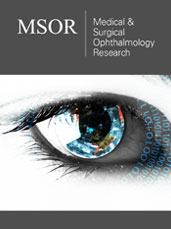- Submissions

Full Text
Medical & Surgical Ophthalmology Research
The Constant Challenge of Visual Rehabilitation in the Patient with Diabetic Retinopathy
Andrea Oleñik M*
Department of Ophthalmology, Hospital Universitario Severo Ochoa, Spain
*Corresponding author: Andrea Oleñik M, Hospital Universitario Severo Ochoa, Madrid, Spain, Tel: ++34606163328; Email:andreaolememmel@gmail.com
Submission: April 18, 2018;Published: May 04, 2018

ISSN 2578-0360 Volume2 Issue1
Opinion
Diabetic macular edema is the first cause of vision loss in these patients; Continuous evolution has allowed intravitreal drugs to improve visual prognosis and quality of life. But... once the process of separation of the layers of the retina by the presence of edema has been initiated and the continuous attempt to restore the quality of vision is a challenge for the current ophthalmologist. It is impossible to predict a result in each patient, since being both angiogenic and inflammatory components involved in the pathophysiology, the general metabolic state plays a crucial role. In the case of diabetes, not only macular edema is present, since microvascular changes throughout the retina affect peripheral vision when they must be treated with laser photocoagulation. If both are present, visual rehabilitation no longer only focuses on the central vision, but on “trying” to preserve as much viable peripheral retinal as possible. This is why we are facing a great problem of visual disability as well as a challenge in visual rehabilitation in a chronic pathology where all these changes could be prevented. What are we failing? Many departments of ophthalmology already perform joint tasks with endocrinologists and nephrologists approaching the patient as “a whole” and not just a local condition, it has been found that the presence of diabetic nephropathy leads to an elevated risk of retinopathy and vice versa. The new therapeutic tools have helped us to address this devastating and disabling pathopathy, as well as new technologies for the screening of these patients. Telemedicine today allows us to perform an inumerable number of retinal revisions that were previously impossible. We are facing a great change in the prevention of this pathology so disabling? I hope so, I hope that both technology and drugs help us that the visual rehabilitation in diabetic patients remain in the history of ophthalmology.
© 2018 Andrea Oleñik M. This is an open access article distributed under the terms of the Creative Commons Attribution License , which permits unrestricted use, distribution, and build upon your work non-commercially.
 a Creative Commons Attribution 4.0 International License. Based on a work at www.crimsonpublishers.com.
Best viewed in
a Creative Commons Attribution 4.0 International License. Based on a work at www.crimsonpublishers.com.
Best viewed in 







.jpg)






























 Editorial Board Registrations
Editorial Board Registrations Submit your Article
Submit your Article Refer a Friend
Refer a Friend Advertise With Us
Advertise With Us
.jpg)






.jpg)














.bmp)
.jpg)
.png)
.jpg)










.jpg)






.png)

.png)



.png)






